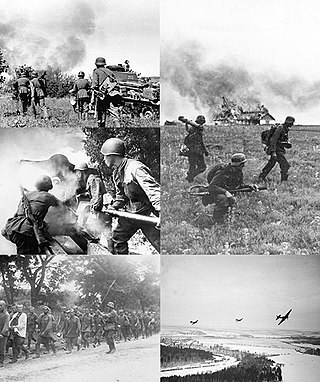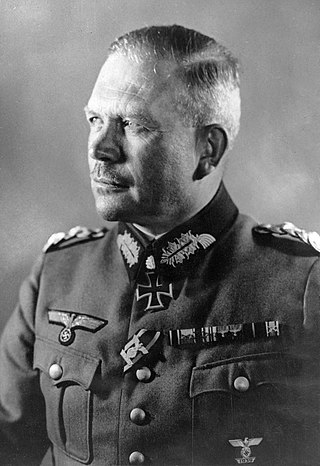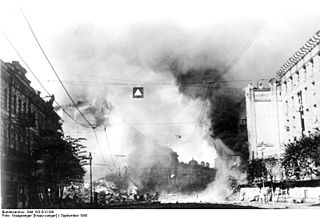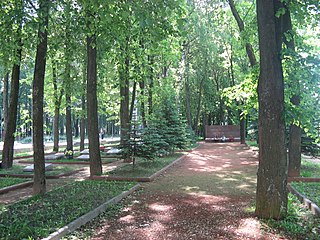Related Research Articles

Operation Barbarossa was the invasion of the Soviet Union by Nazi Germany and many of its Axis allies, starting on Sunday, 22 June 1941, during World War II. It was the largest and costliest land offensive in human history, with around 10 million combatants taking part, and over 8 million casualties by the end of the operation.

Heinz Wilhelm Guderian was a German general during World War II who, after the war, became a successful memoirist. An early pioneer and advocate of the "blitzkrieg" approach, he played a central role in the development of the panzer division concept. In 1936, he became the Inspector of Motorized Troops.

Hermann Hoth was a German army commander, war criminal, and author. He served as a high-ranking panzer commander in the Wehrmacht during World War II, playing a prominent role in the Battle of France and on the Eastern Front. Contemporaries and later historians consider Hoth one of the most talented armoured warfare commanders of the war. He was a strong believer in Nazism, and units under his command committed several war crimes including the murder of prisoners of war and civilians.

The Eastern Front, also known as the Great Patriotic War in the Soviet Union and its successor states, and the German–Soviet War in modern Germany and Ukraine, was a theatre of World War II fought between the European Axis powers and Allies, including the Soviet Union (USSR) and Poland. It encompassed Central Europe, Eastern Europe, Northeast Europe (Baltics), and Southeast Europe (Balkans), and lasted from 22 June 1941 to 9 May 1945. Of the estimated 70–85 million deaths attributed to World War II, around 30 million occurred on the Eastern Front, including 9 million children. The Eastern Front was decisive in determining the outcome in the European theatre of operations in World War II, eventually serving as the main reason for the defeat of Nazi Germany and the Axis nations. It is noted by historian Geoffrey Roberts that "More than 80 percent of all combat during the Second World War took place on the Eastern Front".

The Battle of Moscow was a military campaign that consisted of two periods of strategically significant fighting on a 600 km (370 mi) sector of the Eastern Front during World War II, between October 1941 and January 1942. The Soviet defensive effort frustrated Hitler's attack on Moscow, the capital and largest city of the Soviet Union. Moscow was one of the primary military and political objectives for Axis forces in their invasion of the Soviet Union.

The Commissar Order was an order issued by the German High Command (OKW) on 6 June 1941 before Operation Barbarossa. Its official name was Guidelines for the Treatment of Political Commissars. It instructed the Wehrmacht that any Soviet political commissar identified among captured troops be summarily executed as a purported enforcer of the so-called Judeo-Bolshevism ideology in military forces. It is one of a series of criminal orders issued by the Nazi leadership.

Franz Halder was a German general and the chief of staff of the Army High Command (OKH) in Nazi Germany from 1938 until September 1942. During World War II, he directed the planning and implementation of Operation Barbarossa, the 1941 invasion of the Soviet Union. Halder became instrumental in the radicalisation of warfare on the Eastern Front. He had his staff draft both the Commissar Order and the Barbarossa Decree that allowed German soldiers to execute Soviet citizens for any reason without fear of later prosecution, leading to numerous war crimes and atrocities during the campaign. After the war, he had a decisive role in the development of the myth of the clean Wehrmacht.

The First Battle of Kiev was the German name for the major battle that resulted in an encirclement of Soviet troops in the vicinity of Kiev during World War II, the capital and most populous city of the Ukrainian Soviet Socialist Republic. This encirclement is the largest encirclement in the history of warfare by number of troops. The battle occurred from 7 July to 26 September 1941 as part of Operation Barbarossa, the Axis invasion of the Soviet Union.

The first Battle of Smolensk was a battle during the second phase of Operation Barbarossa, the Axis invasion of the Soviet Union, in World War II. It was fought around the city of Smolensk between 10 July and 10 September 1941, about 400 km (250 mi) west of Moscow. The Ostheer had advanced 500 km (310 mi) into the USSR in the 18 days after the invasion on 22 June 1941.

Erich Kurt Richard Hoepner was a German general during World War II. An early proponent of mechanisation and armoured warfare, he was a Wehrmacht army corps commander at the beginning of the war, leading his troops during the invasion of Poland and the Battle of France.

Gotthard Fedor August Heinrici was a German general during World War II. Heinrici is considered to have been the premier defensive expert of the Wehrmacht. His final command was Army Group Vistula, formed from the remnants of Army Group A and Army Group Center to defend Berlin from the Soviet armies advancing from the Vistula River.

The Yelnya offensive was a military operation by the Soviet Army during the Battle of Smolensk during Operation Barbarossa, the German invasion of the Soviet Union, which began the German-Soviet War. The offensive was an attack against the semi-circular Yelnya salient which the German 4th Army had extended 50 kilometres (31 mi) south-east of Smolensk, forming a staging area for an offensive towards Vyazma and eventually Moscow. Under heavy pressure on its flanks, the German army (Heer) evacuated the salient by 8 September 1941, leaving behind a devastated and depopulated region. As the first reverse that the Heer suffered during Barbarossa and the first recapture of the Soviet territory by the Red Army, the battle was covered by Nazi and Soviet propaganda and served as a morale boost to the Soviet population.

The 4th Panzer Army, operating as Panzer Group 4 from its formation on 15 February 1941 to 1 January 1942, was a German panzer formation during World War II. As a key armoured component of the Wehrmacht, the army took part in the crucial battles of the German-Soviet war of 1941–45, including Operation Barbarossa, the Battle of Moscow, the Battle of Stalingrad, the Battle of Kursk, and the 1943 Battle of Kiev.
The Hunger Plan was a partially implemented plan developed by Nazi bureaucrats during World War II to seize food from the Soviet Union and give it to German soldiers and civilians. The plan entailed the genocide by starvation of millions of Soviet citizens following Operation Barbarossa, the 1941 invasion of the Soviet Union. The plan created a famine as an act of policy, killing millions of people.

Adolf Kurt Ernst Strauß was a German officer who served in the Prussian Army, the Imperial German Army, the Reichswehr, and later as a general in the Heer of Nazi Germany's Wehrmacht during World War II.
Alex J. Kay is a British historian who specialises in Nazi Germany. He has been described as "a leading scholar on the Third Reich and German history" and has become prominent above all as a result of his publications on the Hunger Plan and the genocide of Soviet Jewry.
Ernst Klink was a German military historian who specialised in Nazi Germany and World War II. He was a long-term employee at the Military History Research Office (MGFA). As a contributor to the seminal work Germany and the Second World War from MGFA, Klink was the first to identify the independent planning by the German Army High Command for Operation Barbarossa.
Felix Römer is a German historian who specialises in the history of World War II. He has conducted pioneering research into the implementation of the Commissar Order by combat formations of the Wehrmacht and the attitudes of German soldiers based on the surreptitiously recorded conversations of prisoners of war held in Fort Hunt, Virginia, United States.

Nikolay Ivanovich Vasilyev was a Red Army colonel killed in World War II.
This is a Bibliography of World War II battles and campaigns in Europe, North Africa and the Middle East. It aims to include the major theaters, campaigns and battles of the European theater of World War II. It is part of Wikipedia's larger effort to document the Bibliography of World War II. Its counterpart for the Asia-Pacific theater is the Bibliography of World War II battles and campaigns in East Asia, South East Asia and the Pacific.
References
- Evans, Richard (2012). "Defeat Out of Victory". The New Republic . Archived from the original on 2016-10-25. Retrieved 25 October 2016.